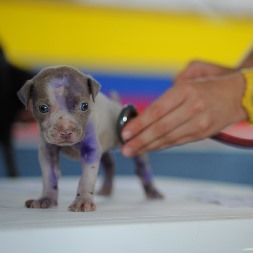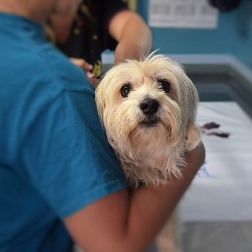How to Enroll In a Vet Tech School near Burns Oregon
 Realizing your long term goal of working with and caring for animals by enrolling in a vet tech school near Burns OR might at first feel like a daunting task. After all, you must search for and enroll in a program that will furnish the appropriate training to ensure that you can be successful as a veterinary technician. But just how do you tackle assessing and contrasting colleges so that you can make the right choice? Many potential students start their due diligence process by looking for campuses that are near their homes. After they have located some local schools, they ascertain which ones have the cheapest tuition and hone in on those. Although location and cost are important factors when comparing vet technician schools, they are not the only significant ones when making your comparisons. Qualifiers such as accreditation and internship programs should be considered also. The point is that there are questions you ought to be asking the vet technician schools you are evaluating before you make a final decision. We have furnished several within this article to help get you started, but before we discuss them we’ll explore the various duties of vet techs and the training options available.
Realizing your long term goal of working with and caring for animals by enrolling in a vet tech school near Burns OR might at first feel like a daunting task. After all, you must search for and enroll in a program that will furnish the appropriate training to ensure that you can be successful as a veterinary technician. But just how do you tackle assessing and contrasting colleges so that you can make the right choice? Many potential students start their due diligence process by looking for campuses that are near their homes. After they have located some local schools, they ascertain which ones have the cheapest tuition and hone in on those. Although location and cost are important factors when comparing vet technician schools, they are not the only significant ones when making your comparisons. Qualifiers such as accreditation and internship programs should be considered also. The point is that there are questions you ought to be asking the vet technician schools you are evaluating before you make a final decision. We have furnished several within this article to help get you started, but before we discuss them we’ll explore the various duties of vet techs and the training options available.
The Job of a Veterinary Technician in Burns OR
 One of the first decisions that you will need to make is if you wish to train as a veterinary assistant, technician or technologist. Part of your preference may be predicated on the amount of time and money that you have to devote to your education, but the primary determiner will most likely be which specialty appeals to you the most. What technicians and assistants have in common is that they both work under the immediate guidance of a practicing and licensed veterinarian. And although there are a number of functions that they can perform within the Burns OR veterinary practice or hospital, they can’t prescribe medications, diagnose conditions, or carry out surgeries. In those areas they may only provide support to a licensed veterinarian. There are technologists and technicians that work away from the standard vet practice, for instance for zoos, animal shelters or law enforcement. Let’s take a look at the job functions and training prerequisites for each specialty.
One of the first decisions that you will need to make is if you wish to train as a veterinary assistant, technician or technologist. Part of your preference may be predicated on the amount of time and money that you have to devote to your education, but the primary determiner will most likely be which specialty appeals to you the most. What technicians and assistants have in common is that they both work under the immediate guidance of a practicing and licensed veterinarian. And although there are a number of functions that they can perform within the Burns OR veterinary practice or hospital, they can’t prescribe medications, diagnose conditions, or carry out surgeries. In those areas they may only provide support to a licensed veterinarian. There are technologists and technicians that work away from the standard vet practice, for instance for zoos, animal shelters or law enforcement. Let’s take a look at the job functions and training prerequisites for each specialty.
- Vet Assistants in most cases will have gone through a structured training program, either as an apprentice or intern in a practice, or by finishing a certificate program at a vocational school or community college. As the name implies, their job function is to assist the veterinarians and vet techs in the completion of their duties. Usually they are not associated with more complicated tasks, for instance assisting with surgeries. Some of their typical functions may include working at the front desk, cleaning and preparing exam rooms and equipment, or handling pets during examinations.
- Vet Technicians get more advanced training compared with assistants and usually obtain a 2 year Associate Degree, ideally from an American Veterinary Medical Association (AVMA) accredited program. They are in a sense the veterinarian counterparts of medical nurses, since their general job function is to assist veterinarians with diagnosing and treating animal patients. Where they vary from veterinary assistants is that they are included in more complex functions, for example assisting with surgeries or administering medicine. All states presently mandate that vet technicians pass a credentialing examination for either registration, certification or licensing.
- Vet Technologists are similar to vet techs and basically carry out the same work functions. They are mandated to attain a Bachelor’s Degree in veterinary technology, which normally takes four years to complete. So the only real distinction between a vet technician and a technologist is the technologist’s more advanced level of education. But with an advanced degree comes more work options, higher salaries and potential management positions. They are also required to pass a credentialing examination for either registration, certification or licensing.
Veterinary technicians and technologists may specialize in areas such as anesthesia, internal medicine or urgent care. Many may receive certification from the American Association for Laboratory Animal Science (AALAS) to work in Burns OR labs or research facilities as well.
Online Veterinary Technician Schools Offered in Burns
 An option that might be a solution for those with a busy lifestyle or who are working full time while attending veterinarian college is to enroll in an online training program. Since the classes are made available via the internet, students can attend on their own timetable wherever a computer is available. The syllabus is taught using various venues, including slide shows, videos and live streaming webinars. And since most veterinary tech and technologist degrees require practical training, that part can usually be carried out as an internship or work study program at a local Burns OR veterinarian practice or hospital. Distance learning, as it is also called, can in many instances reduce the cost of your education. Tuition and ancillary expenses, for instance for traveling and study materials, may be cheaper compared to more traditional classroom courses. Just confirm that the program that you enroll in is accredited, either by the AVMA or another nationally recognized accrediting organization. With the online classes and the clinical training, everything is included for a comprehensive education. So if you are dedicated enough to learn in this more independent fashion, an online veterinary technician program may be the ideal option for you.
An option that might be a solution for those with a busy lifestyle or who are working full time while attending veterinarian college is to enroll in an online training program. Since the classes are made available via the internet, students can attend on their own timetable wherever a computer is available. The syllabus is taught using various venues, including slide shows, videos and live streaming webinars. And since most veterinary tech and technologist degrees require practical training, that part can usually be carried out as an internship or work study program at a local Burns OR veterinarian practice or hospital. Distance learning, as it is also called, can in many instances reduce the cost of your education. Tuition and ancillary expenses, for instance for traveling and study materials, may be cheaper compared to more traditional classroom courses. Just confirm that the program that you enroll in is accredited, either by the AVMA or another nationally recognized accrediting organization. With the online classes and the clinical training, everything is included for a comprehensive education. So if you are dedicated enough to learn in this more independent fashion, an online veterinary technician program may be the ideal option for you.
Questions to Ask Burns OR Vet Tech Schools
 At this point you should have determined which veterinarian degree that you would like to obtain, and if you intend to study online or attend a school on campus. Since there are an abundance of vet community colleges, technical and vocational schools in the Burns OR area and across the USA, you must ask some relevant questions in order to narrow down your list of alternatives. As we discussed in our opening, many potential students start by prioritizing location and tuition expense. But we have previously touched on other important qualifiers, for example internship programs and accreditation. And of course you want to select a college that offers the specialty and degree that you want to earn. These and other factors are addressed in the list of questions that you should ask the veterinary technician schools that you are looking at.
At this point you should have determined which veterinarian degree that you would like to obtain, and if you intend to study online or attend a school on campus. Since there are an abundance of vet community colleges, technical and vocational schools in the Burns OR area and across the USA, you must ask some relevant questions in order to narrow down your list of alternatives. As we discussed in our opening, many potential students start by prioritizing location and tuition expense. But we have previously touched on other important qualifiers, for example internship programs and accreditation. And of course you want to select a college that offers the specialty and degree that you want to earn. These and other factors are addressed in the list of questions that you should ask the veterinary technician schools that you are looking at.
Is the Vet School Accredited? It’s imperative that you confirm that the veterinary technician college you enroll in is accredited by a regional or national accrediting agency. As earlier discussed, among the most highly respected is the American Veterinary Medical Association (AVMA). Trade schools and colleges that are accredited by the AVMA have undergone an extensive screening process that verifies you will obtain a quality education. Also, accreditation is important if you are requesting a student loan or financial aid, since many programs are not obtainable for non-accredited programs. And finally, having a certificate or degree from an accredited school is often a prerequisite for employment for many Burns OR area veterinarian practices and hospitals.
What is the College’s Reputation? The veterinary college or vocational school and program you select must have an outstanding reputation within the vet field. You can start your due diligence by asking the colleges you are looking at for references from the employers in their job placement network. Other pointers include checking with online school rating websites and speaking with the school’s accrediting agencies as well. You can ask the Oregon school licensing department if there have been any grievances or violations involving your specific schools. As a final suggestion, call some Burns OR vet clinics that you may wish to work for after you receive your training. Ask what they think of your school choices. They may even recommend one or more colleges not on your list.
Are Internships Offered? The best approach to obtain clinical hands on training as a vet tech is to work in a professional environment. Find out if the colleges you are considering have internship programs arranged with Burns OR veterinarians, vet hospitals or clinics. Most veterinary medicine programs require clinical training and a large number furnish it by way of internships. Not only will the experience be valuable regarding the clinical training, but an internship can also help build connections in the local veterinary community and aid in the search for a position after graduation.
Is Job Placement Offered? Searching for a job after graduating from a veterinary technician school can be difficult without the assistance of a job placement program. To begin with, ask what the graduation rates are for the colleges you are evaluating. A low rate might mean that the teachers were unqualified to teach the syllabus or that some students were unhappy with the program and quit. Next, verify that the schools have a job assistance program and ask what their placement rates are. A higher placement rate could indicate that the college has an exceptional reputation within the Burns OR veterinary community and has a considerable network of contacts for student placements. A lower rate could indicate that the training is not well thought of by employers or that the job assistance program is ineffective at placing students.
How Large are the Classes? If the classes are larger in size, you probably will receive little or no individualized instruction from the teachers. Request from the Burns OR colleges you are researching what their class student to teacher ratios are. You may also decide to participate in a few classes (if practical) to monitor the interaction between instructors and students. Get evaluations from students relating to the quality of instruction. Also, speak with the teachers and find out what their qualifications are as well as their approaches to teaching.
Where is the School Located? Okay, we already discussed location, but there are several more points to make on the topic. If you are planning to commute to your vet tech classes from your Burns OR home, you need to make sure that the driving time fits into your schedule. For example, driving during the weekend to investigate the route won’t be the same as the drive during rush hour traffic, especially if the college is located close by or within a larger city. Also, if you do opt to attend a college in another state or even outside of your County of residence, there may be increased tuition costs especially for state and community colleges. Of course taking classes online might be an alternative that will give you more flexibility and decrease the need for travel.
Is the Class Schedule Flexible? And last, it’s important that you determine if the veterinarian programs you are looking at offer class times flexible enough to fit your schedule. For instance, many students continue working full time and can only attend classes on the weekends or at night near Burns OR. Some may only be able to attend class in the morning or in the afternoon. Make sure that the class times you require are offered prior to enrolling. In addition, find out if you can make-up classes that you might miss due to work, illness or family issues. You might discover that an online school is the ideal way to fit your vet training into your hectic life.
Enrolling in a Vet Tech School near Burns OR?
If you have decided to attend a Veterinary Technician Program in the Burns Oregon area, then you may find the following information about the location of your school campus interesting and informing.
Burn
A burn is a type of injury to skin, or other tissues, caused by heat, cold, electricity, chemicals, friction, or radiation.[3] Most burns are due to heat from hot liquids, solids, or fire.[7] While rates are similar for males and females the underlying causes often differ.[4] Among women in some areas, risk is related to use of open cooking fires or unsafe cook stoves.[4] Among men, risk is related to the work environments.[4]Alcoholism and smoking are other risk factors.[4] Burns can also occur as a result of self harm or violence between people.[4]
Burns that affect only the superficial skin layers are known as superficial or first-degree burns.[1][8] They appear red without blisters and pain typically lasts around three days.[1][8] When the injury extends into some of the underlying skin layer, it is a partial-thickness or second-degree burn.[1] Blisters are frequently present and they are often very painful.[1] Healing can require up to eight weeks and scarring may occur.[1] In a full-thickness or third-degree burn, the injury extends to all layers of the skin.[1] Often there is no pain and the burnt area is stiff.[1] Healing typically does not occur on its own.[1] A fourth-degree burn additionally involves injury to deeper tissues, such as muscle, tendons, or bone.[1] The burn is often black and frequently leads to loss of the burned part.[1][9]
Burns are generally preventable.[4] Treatment depends on the severity of the burn.[1] Superficial burns may be managed with little more than simple pain medication, while major burns may require prolonged treatment in specialized burn centers.[1] Cooling with tap water may help pain and decrease damage; however, prolonged cooling may result in low body temperature.[1][8] Partial-thickness burns may require cleaning with soap and water, followed by dressings.[1] It is not clear how to manage blisters, but it is probably reasonable to leave them intact if small and drain them if large.[1] Full-thickness burns usually require surgical treatments, such as skin grafting.[1] Extensive burns often require large amounts of intravenous fluid, due to capillary fluid leakage and tissue swelling.[8] The most common complications of burns involve infection.[2]Tetanus toxoid should be given if not up to date.[1]
Enroll in the Ideal Veterinary Technician School near Burns OR
 Enrolling in the right vet tech college is a crucial first step to starting a rewarding career delivering care and treatment for pets and livestock. Students thinking about veterinary technician programs need to make their decision based on multiple key factors. Veterinary technicians and technologists work in vet clinics, animal hospitals and animal shelters. They typically take on administrative tasks and assist the veterinarian with the animals as needed. As we have discussed, it’s very important that you choose a veterinary medicine program that is both accredited and has an excellent reputation within the profession. This goes for online vet tech programs as well. By asking the questions included in our checklist for reviewing schools, you will be able to reduce your alternatives so that you can make your final selection. And by selecting the right college, you can accomplish your goal of becoming a veterinary technician in Burns OR.
Enrolling in the right vet tech college is a crucial first step to starting a rewarding career delivering care and treatment for pets and livestock. Students thinking about veterinary technician programs need to make their decision based on multiple key factors. Veterinary technicians and technologists work in vet clinics, animal hospitals and animal shelters. They typically take on administrative tasks and assist the veterinarian with the animals as needed. As we have discussed, it’s very important that you choose a veterinary medicine program that is both accredited and has an excellent reputation within the profession. This goes for online vet tech programs as well. By asking the questions included in our checklist for reviewing schools, you will be able to reduce your alternatives so that you can make your final selection. And by selecting the right college, you can accomplish your goal of becoming a veterinary technician in Burns OR.
Other Doggone Good Cities in Oregon

